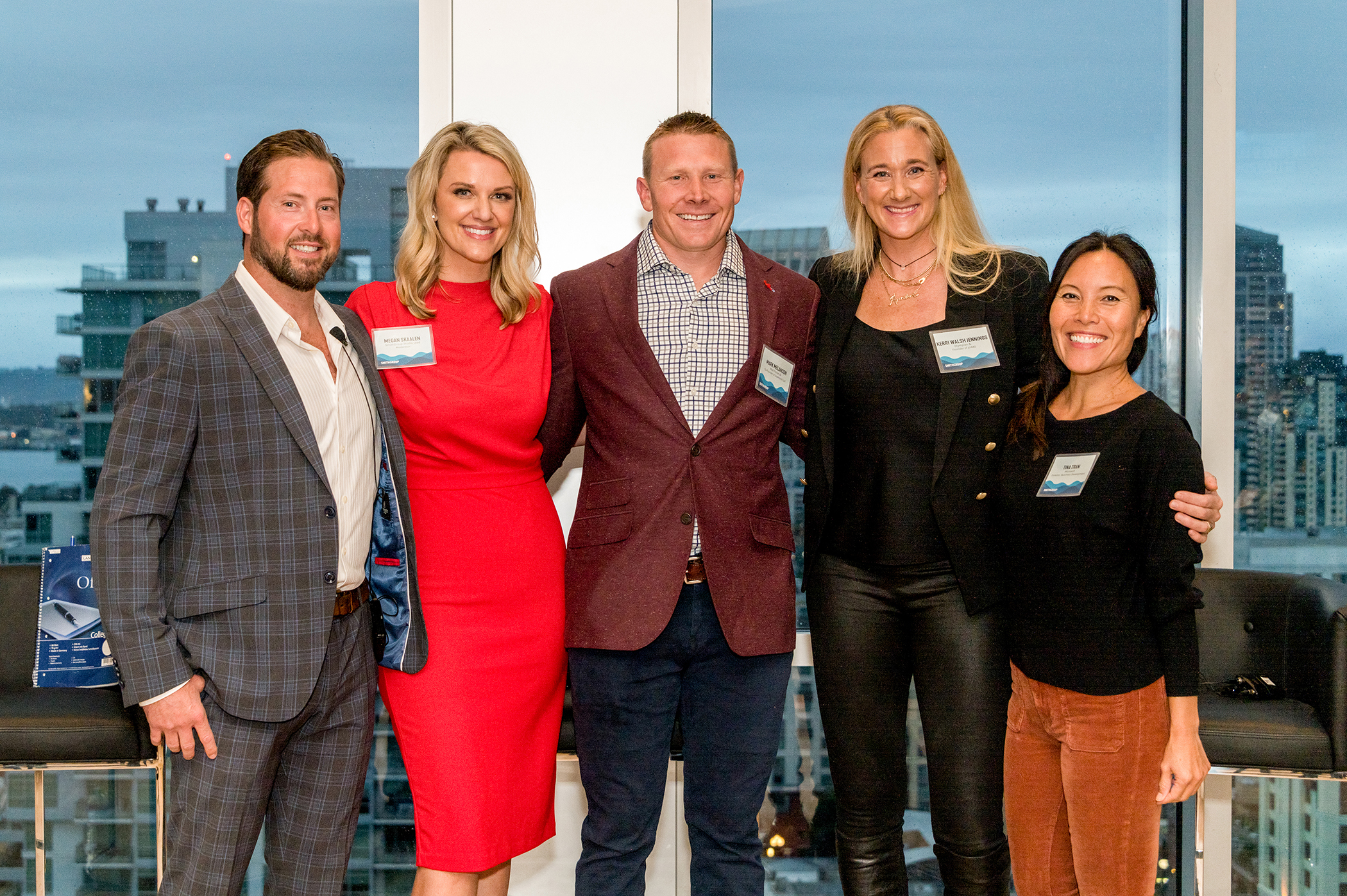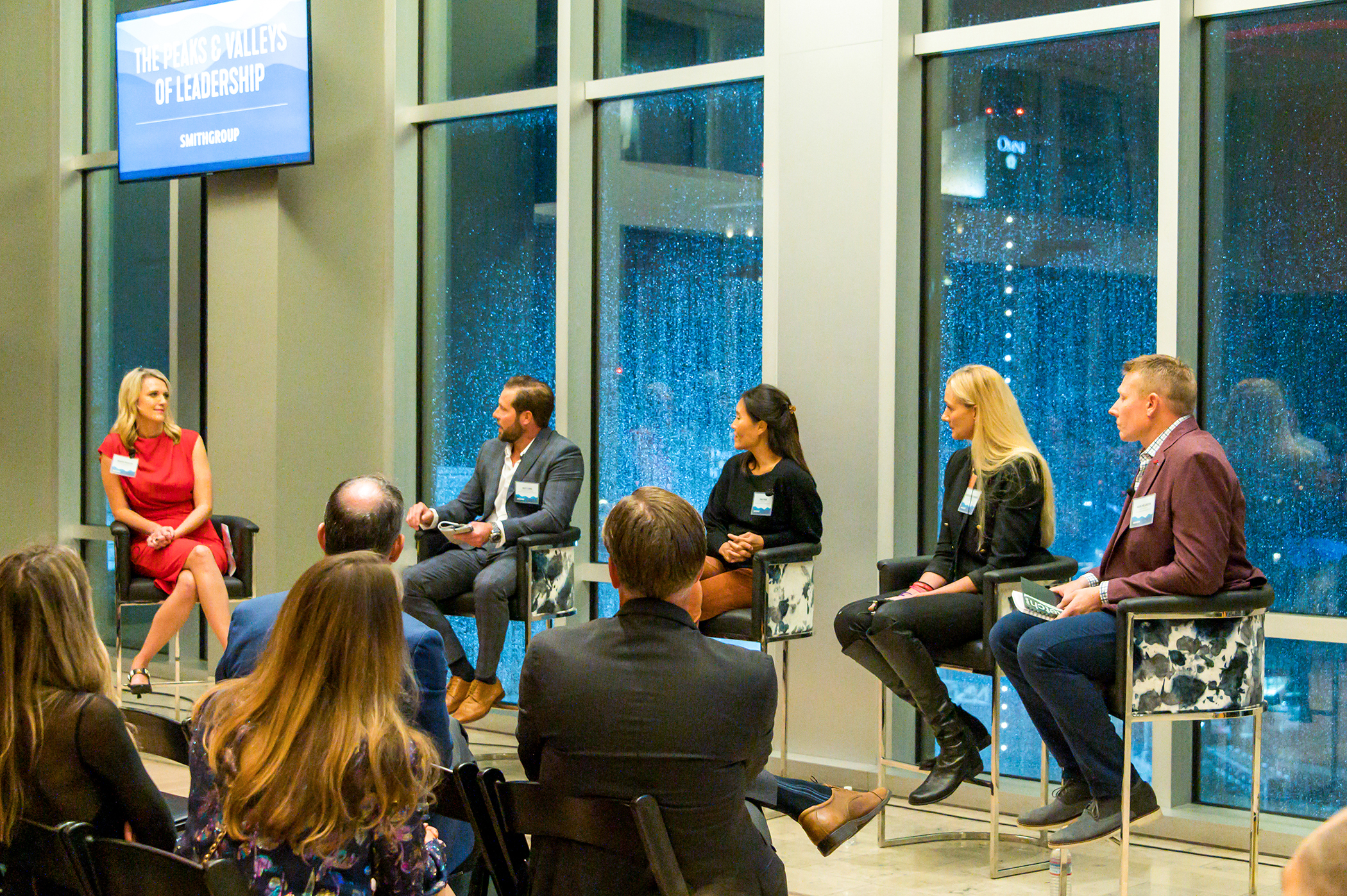The Peaks and Valleys of Leadership
What would it look like to bring together leadership perspectives that were tested in extraordinary ways?
This question guided a recent Perspectives panel event hosted by SmithGroup on the peaks and valleys of leadership. A rare rainy evening in San Diego served as the backdrop for an incredible conversation and a serendipitous message that storms bring the opportunity for growth. The objective of the event was to showcase unique leadership perspectives with the goal of inspiring the audience, sparking ideas and making connections. The panelists included:
- Kerri Walsh Jennings - Professional beach volleyball player, five-time Olympian, three-time Olympic gold medal winner, one-time bronze medalist and founder of p1440 volleyball event series
- Tina Tran - Director of Consumer Partnerships at Microsoft who has led business development at three successfully acquired video game and technology startups, advisor to multiple organizations and board member for Hello Neighbor
- Mark Melancon - Major League Baseball pitcher currently with the Arizona Diamondbacks, four-time MLB All-Star and co-founder of Diamond Turf
- Matt Long - Retired U.S. Navy SEAL Team leader who served 20 years in the special operations community, earning a Silver Star and multiple Bronze Stars with Valor, and founder of Long Range Solutions LLC
As the panelists offered various experiences and views on leadership from their respective fields—ranging from professional sports to business to the military—common themes arose with valuable takeaways.
BUILDING TRUST IS PARAMOUNT FOR HIGH-PERFORMING TEAMS
Kerri Walsh Jennings, half of one of the greatest duos in beach volleyball history, emphasized the importance of trust, win or lose: “The best partnerships I’ve ever had have been when we have a clear common mission, and we never lose sight of it... What made Misty May-Treanor and I special, I believe, is obviously that we fit each other, are very complementary of each other and very different in so many ways. But when we’d lose, which barely happened, thank goodness, we were so committed to each other we would walk off the court arm in arm.”
To build trust, you need to show that you yourself are human. "Still trying to be the best but coming at it with a perspective that you are trying to build the team up rather than only yourself—eliminating the ego—allows people to be vulnerable,” said Matt Long of his time as a Navy SEAL. Mark Melancon concurred: “The best leaders create that trust. It takes time to build but…that has always been the most important thing.”
Whether you are leading a team on a mission, the baseball field, volleyball court or in business, the same principle of building trust applies.
SET A CLEAR VISION
Leaders don’t have all the answers, but they need to have a clear vision. When Matt prepared his teams for missions, he focused on “creating a narrative and telling the story in a way that helped them understand the vision. Everyone has different experience levels—look at the perspective of how others are looking at a job and/or project. Overcommunicate the plan and vision.”
Similarly, when Kerri encounters ambiguity, her success—and therefore her team’s success—has everything to do with her approach to it. “Uncertainty is something I have trained myself to smile at. Uncertainty, like adversity, is there to fortify me and make me look in the mirror: ‘What do you got here? What do you want here?’ The questions you ask yourself in stress and duress are important.”
Across all the panelist perspectives, there was a recurring message of communicating a clear common mission, as well as the importance of leading oneself first through personal accountability and sincerity.
SURROUND YOURSELF WITH GREATNESS
Another key theme revolved around the company you keep. Tina Tran suggested looking at the competition in the corporate environment: “I look at people who are excelling and I ask myself, ‘What are they doing that is awesome and how can I model that,’ rather than get envious. ‘They did this well, what can I learn from that? How can I be better and use competition to drive me?’” This perspective creates an opportunity for a rising tide to lift all boats.
Mark agreed: “Whenever you can get close to someone and feel like they are going to have your back… and are working as hard as you are and pulling you up—it’s not always easy to find but when you do you know you have someone solid—the fun part has been seeing successful people next to you.” He went on to share that it’s also important what you tell yourself: “I should be continually going up—that is the mindset you have to consistently have.”
Surrounding yourself with people who inspire you and owning your narrative were consistent throughlines of the evening.
FEAR IS OPPORTUNITY
Without a doubt, every leader has had moments they were afraid, even the most decorated beach volleyball Olympian of all-time. Kerri shared there was a period she had been playing in fear and had grown sick of it: “I truly believe that the truth of who I am is unafraid. God designed me and I have everything within me to handle these situations.” She made the decision to start living in the true spirit of competition and celebrate the moment and is continuing to do so, recently announcing a new partnership with previous Stanford teammate, Logan Tom.
Facing fears takes many forms. Tina shared, “being in tech I’ve been laid off three times, maybe four. I think the most important thing to think about is what you have agency over. There’s stuff going on in the world that you, like everyone else, have no control over. The way that I manage uncertainty is that I have control over what actions I take instead of stressing about things I can’t control.” She went on to add. “I have a postcard on my refrigerator that I look at every day and it says, ‘What would you do if you weren’t afraid?’ That is important because it allows me to live to my full potential and to stop and think what is that instinctive answer? Why am I scared of it and what would it look like if I could conquer it?” So now she encourages others to ask, “What would you do if you weren’t afraid? Let’s be limitless.”
As Workplace Studio Leader in SmithGroup’s San Diego office, it is my job to encourage my teammates, partners and clients to be limitless. As we collaborate with organizations across a wide range of industries, our goal is to create a limitless vision for what the built environment can be. How can it reflect the leadership culture of an organization, positively impact the users and improve the bottom line? For us, that’s Designing a Better Future unafraid. What does being limitless look like for you?

